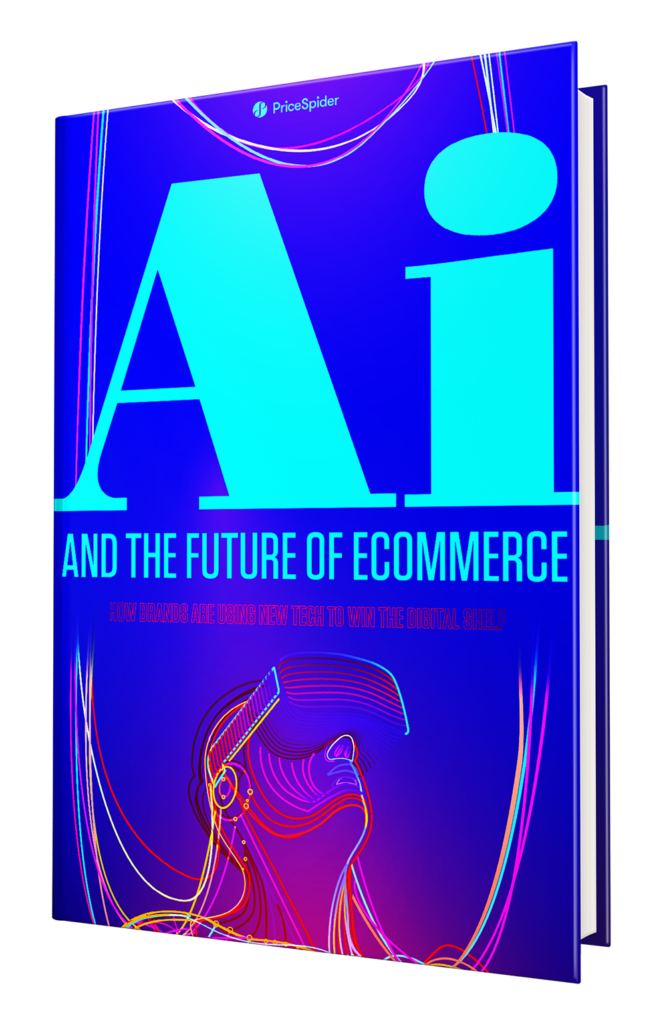In pop culture, the story goes something like this: Humans develop artificial intelligence (AI), the AI gains consciousness, the humans lose control of it, and next thing you know, the machines are on a mission to take over the world.
But of course, that’s all fiction. In the real world, while AI is capable of doing some amazing things, the technology is still very much in its infancy.
For example, modern AI image generators like Midjourney and Stable Diffusion produce semi-realistic images based on various prompts. And the perhaps even more well-known ChatGPT has gained popularity for generating human-like text.
Amidst this surge of interest, brands are looking for ways to capitalize on AI. But what exactly does that mean? And what implications does it hold for the world of ecommerce?
At PriceSpider, we envision AI as ecommerce’s future. The question is not whether AI will transform ecommerce, but rather how and when it will happen. And our aim is to keep you at the forefront of this technological shift.
In this blog, we’ll take a brief look at what “AI” really means and then explore seven practical ways brands are already applying it to their ecommerce operations.
What do we mean by “AI”?
There are two primary types of AI: General intelligence and narrow intelligence.
General intelligence depicts AI akin to science fiction, where machines possess consciousness and human-like thinking abilities. But like we said before, achieving this level of artificial intelligence is far from reality at the moment.
On the other hand, whileChatGPT has impressive writing capabilities, these abilities arise from recognizing patterns and reproducing them based on new prompts. This process lacks conscious thought – it’s just an imitation of patterns.
That means ChatGPT and existing AI fall into the realm of narrow intelligence, powerful technology mimicking intelligence but lacking true independent thinking.
There are several forms of narrow AI currently being used:
- Machine learning: Much of what we refer to as AI relies on machine learning to varying degrees. Machine learning employs algorithms to analyze extensive data for patterns and correlations, facilitating decision-making and predictions.
- Generative AI: Generative AI is essentially a specialized form of machine learning. This category encompasses natural language processing (e.g., ChatGPT and Google Bard), image processing (e.g., Midjourney and Stable Diffusion), and even audio and video processing. Generative AI processes substantial human-generated data (text, images, etc.) and “predicts” outcomes like text or images based on provided prompts.
- Data mining: Although less flashy than generative AI, data mining holds significant value for ecommerce brands. Data mining is a straightforward concept predating machine learning. It involves extracting substantial data to unveil patterns and relationships useful for problem-solving. While machine learning emphasizes data training, data mining centers on initial data discovery.
For a more in-depth look at AI and how brands are using it for ecommerce, check out our free ebook, AI and the Future of Ecommerce: How Brands Are Using New Tech to Win the Digital Shelf.
7 key ways ecommerce brands are using AI
While the technology still feels quite new, several brands are harnessing AI to optimize their ecommerce operations – and some of them are already seeing success with it. Let’s take a look at some of the ways brands are putting AI to use.
1. Streamlining customer onboarding
Bringing new customers on board ideally includes making the process as easy as possible, gathering data, and encouraging them to make additional purchases, post reviews, etc. Brands can use generative AI to contribute to the design of their onboarding platform and create copy to move users from one stage to another. Some AI tools can even create onboarding videos with realistic presenters, often at a much lower cost.
2. Enhancing customer service chatbots
Traditional automated customer service chatbots are often despised because their predefined prompts don’t always accurately represent the customer’s problem, leading to frustration and lost sales. But advanced natural language processing has started to reshape the chatbot landscape. For example, Amazon has introduced AI chatbots that understand and resolve customer issues using everyday language. This setup helps minimize wait times, saves human reps from having to deal with repetitive requests, and ultimately preserves time and money for businesses.
3. Scraping websites
Website scraping for competitive analysis and consumer insights predates AI, but it has become more powerful and useful with AI integration. Scraping historically relied on predefined patterns to extract data elements like product details, reviews, and prices, susceptible to errors from webpage variations. But AI’s natural language processing enables much more dynamic comprehension of websites, enhancing data extraction accuracy, accommodating typos, and reducing the need for extra programming.
4. Bolstering purchasing behavior analysis
Ecommerce brands traditionally track customer purchasing behavior to spot trends and make forecasts, but the integration of machine learning takes these capabilities to new levels. AI facilitates data connections and insights beyond manual analysis, comprehending customers’ potential wants and needs based on past actions. For example, Amazon uses AI for their personalized product recommendations, and streaming services like Netflix use AI to recommend additional content based on viewing history.
5. Generating product descriptions
Generative AI tools like ChatGPT are useful for automating copywriting tasks, producing comprehensive product descriptions with minimal input. But while AI swiftly generates text, accuracy can vary, and factual errors might lead to missed sales, customer frustration, or legal issues. Balancing AI’s assistance with human oversight is crucial. Generative AI can initiate brainstorming and drafting, but human intervention is still needed for refining, fact-checking, and ensuring professional output.
6. Improving search engines
AI can enhance search experiences by streamlining user queries and product suggestions. For instance, Bing employs ChatGPT’s natural language processing to synthesize web information into concise answers to search queries. Ecommerce can benefit from this, too, enabling users to describe products naturally and bypass complex filters. When searching for a gaming PC, for example, a user might normally need to apply filters for things like RAM, GPU, and SSD. But with an AI-powered search engine, they could simply say, “I need a gaming PC that meets the minimum requirements for X game,” and the AI could show them exactly what they’re looking for.
7. Coding
AI tools like ChatGPT can be used for coding tasks, but with varying proficiency. Right now, ChatGPT can craft code for simple routines that can be integrated into larger projects. But asking it to construct complete applications often results in confusion, disregarding parameters, and generating subpar code. It’s important to note that ChatGPT excels in coding for established problems but struggles with novel challenges, which is why expert developers are still essential for guiding and refining AI-driven code.
Stay on the cutting edge of brand ecommerce
These AI applications are just the beginning, and PriceSpider aims to lead AI-driven innovation in the ecommerce space as it continues to develop in the future. Even right now, PriceSpider is at the forefront of the industry, helping brands grow revenue and market share via our leading brand commerce platform.
Want to know how PriceSpider can help you optimize the buyer journey, protect brand integrity, enforce pricing policies and much more? Talk to an expert today.


